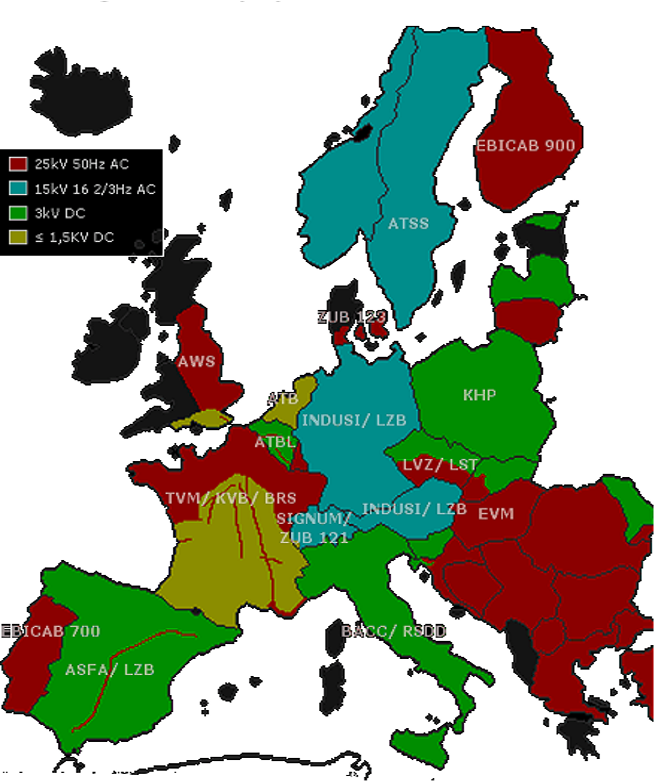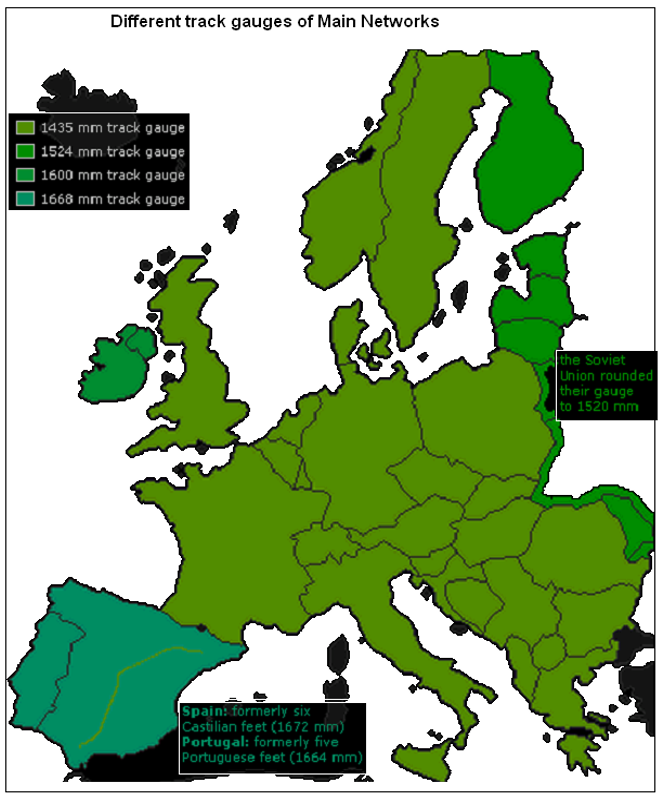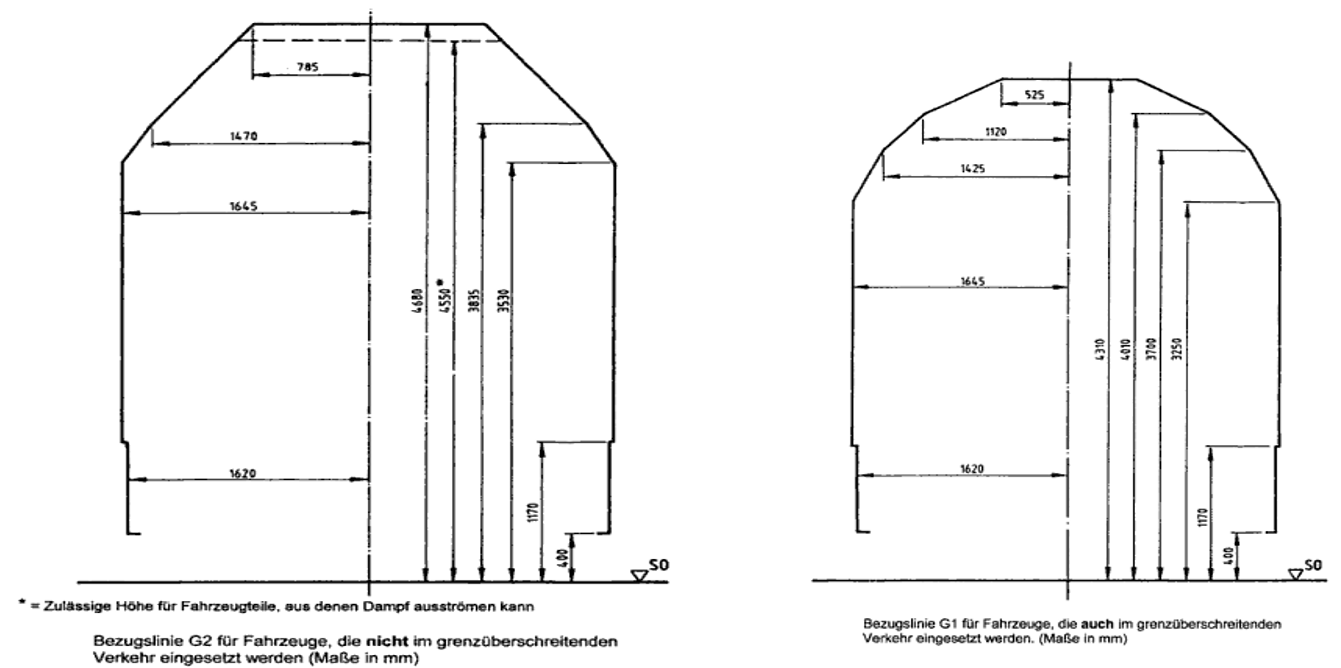Rail Transport System
| Website: | Hamburg Open Online University |
| Kurs: | MoGoLo - Mobility of Goods and Logistics Systems |
| Buch: | Rail Transport System |
| Gedruckt von: | Gast |
| Datum: | Donnerstag, 27. November 2025, 03:16 |
Beschreibung
In this section you will learn more about the rail transport system and its different elements goods, trains, railways and railway stations. This topic follows the structure of the conceptual system model of transport and traffic.
1. Introduction
In this section, you will learn more about the rail transport system. After the activities, the goods, that are transported by rail are presented to you. Rail transport requires trains, railways and railway stations, so you will also learn more about those elements. To summarize the section of rail transport, some advantages and disadvantages of the rail transport system will be presented.
The figure "Rail system model" shows the structure of the content of this topic.
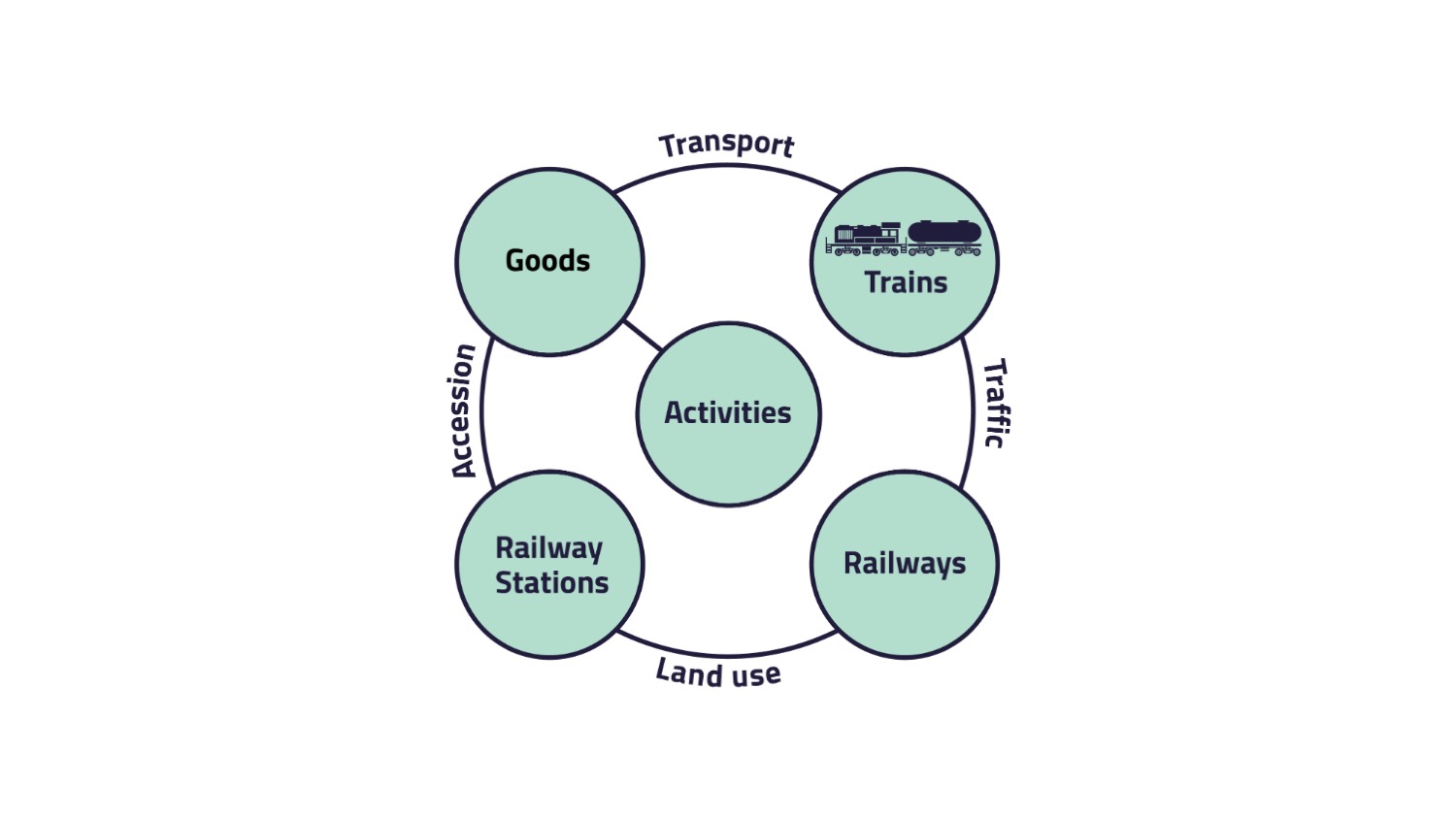
Literature
2. Activities
On this page, the element "Activities" is presented.
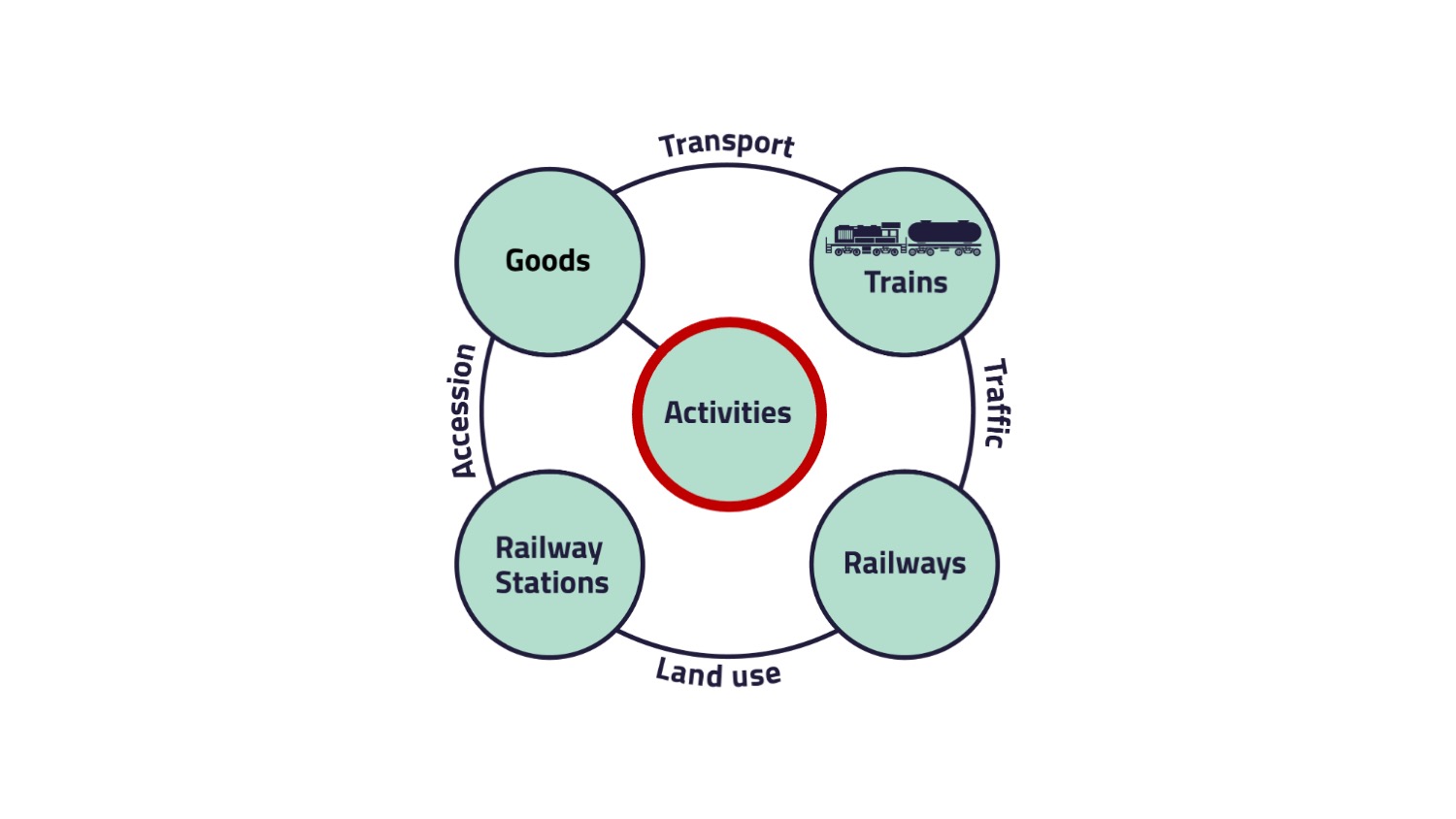
- We as consumers drive the system.
- The order is the steering medium.
Literature
3. Goods
The second element "Goods" of the conceptual system model relates to the goods transported by rail freight transport.
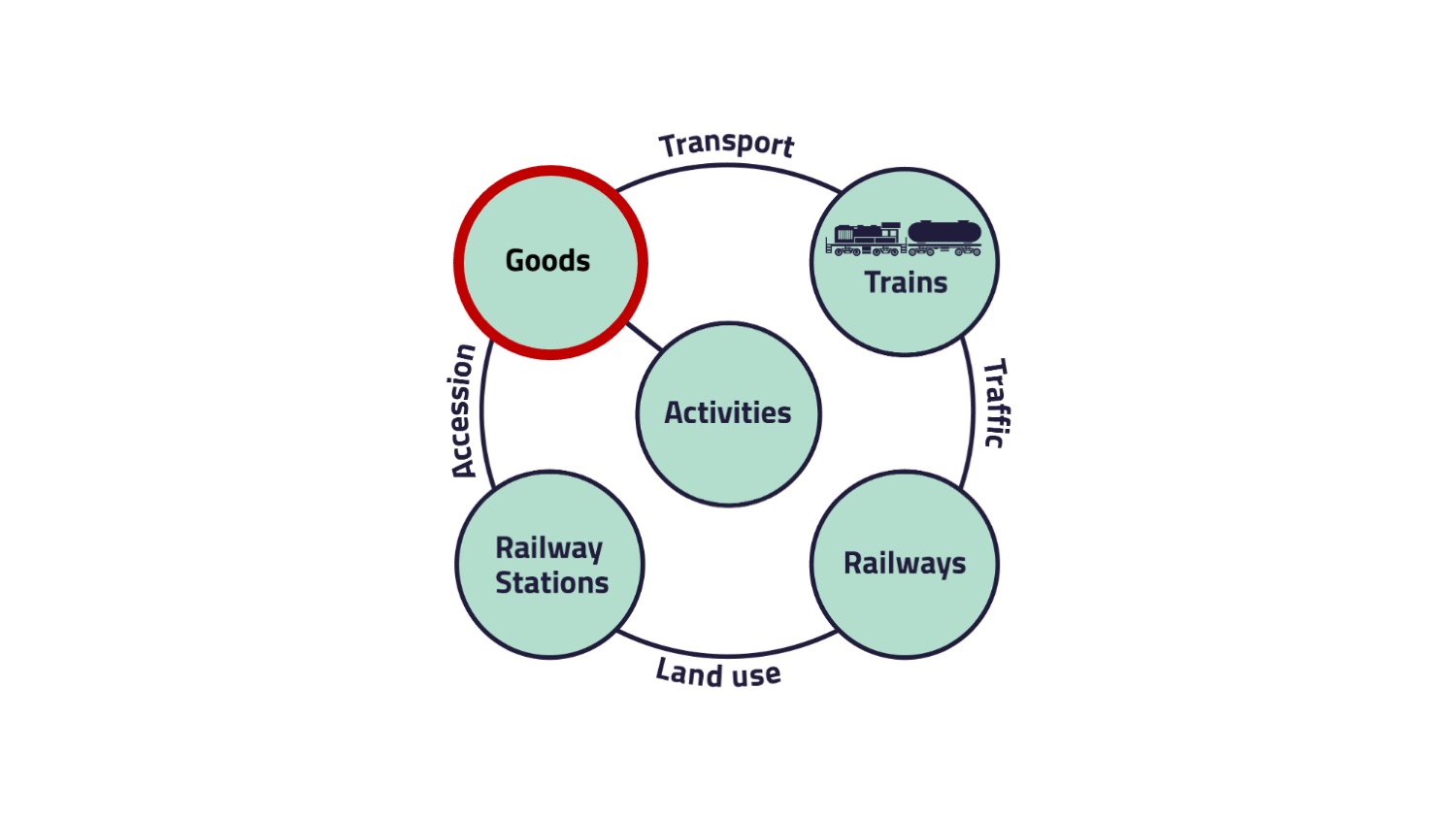
- bulk goods, e.g. iron, steel, etc.
- building materials as well as garbage and waste
- liquids, mineral oil and chemical products
- agricultural and forestry products
- consumer goods
- food and therefore perishable goods which must be temperature-controlled
- cars and car components
- hazardous goods
- heavy load transports and special transports
The relation between goods and trains is called transport.
As in road transport, the transport volume in rail freight transport is increasing in recent years. This development will be shown to you in the following paragraph.
Transport
The transport volume and transport performance in Germany are rising, in particular due to the increase in the average transport distance from 192 km in 1992 to 331 km in 2019.
On the next page, the trains needed for rail transport are presented to you.
Literature
Bundesministerium für Verkehr und digitale Infrastruktur (2020): Verkehr in Zahlen 2020/2021. 49. Jahrgang, URL: https://www.bmvi.de/SharedDocs/DE/Publikationen/G/verkehr-in-zahlen-2020-pdf.pdf?__blob=publicationFile (last access: 30.03.2022)
European Commission (2020): EU Transport Figures. Statistical Pocketbook 2020. URL: https://publications.europa.eu/resource/cellar/da0cd68e-1fdd-11eb-b57e-01aa75ed71a1.0001.03/DOC_1 (last access: 30.03.2022)
Flämig, H., Sjöstedt, L., Hertel, C. (2002): Multimodal Transport: An Integrated Element for Last-Mile-Solutions? Proceedings, part 1; International Congress on Freight Transport Automation and Multimodality: Organisational and Technological Innovations. Delft, 23 & 24 May 2002. (modification of Sjöstedt 1996)
4. Trains
On this page, the element "Trains" is introduced. We will discuss different types of trains and traffic volumes. In addition, we will show you, in which different ways trains are operating.
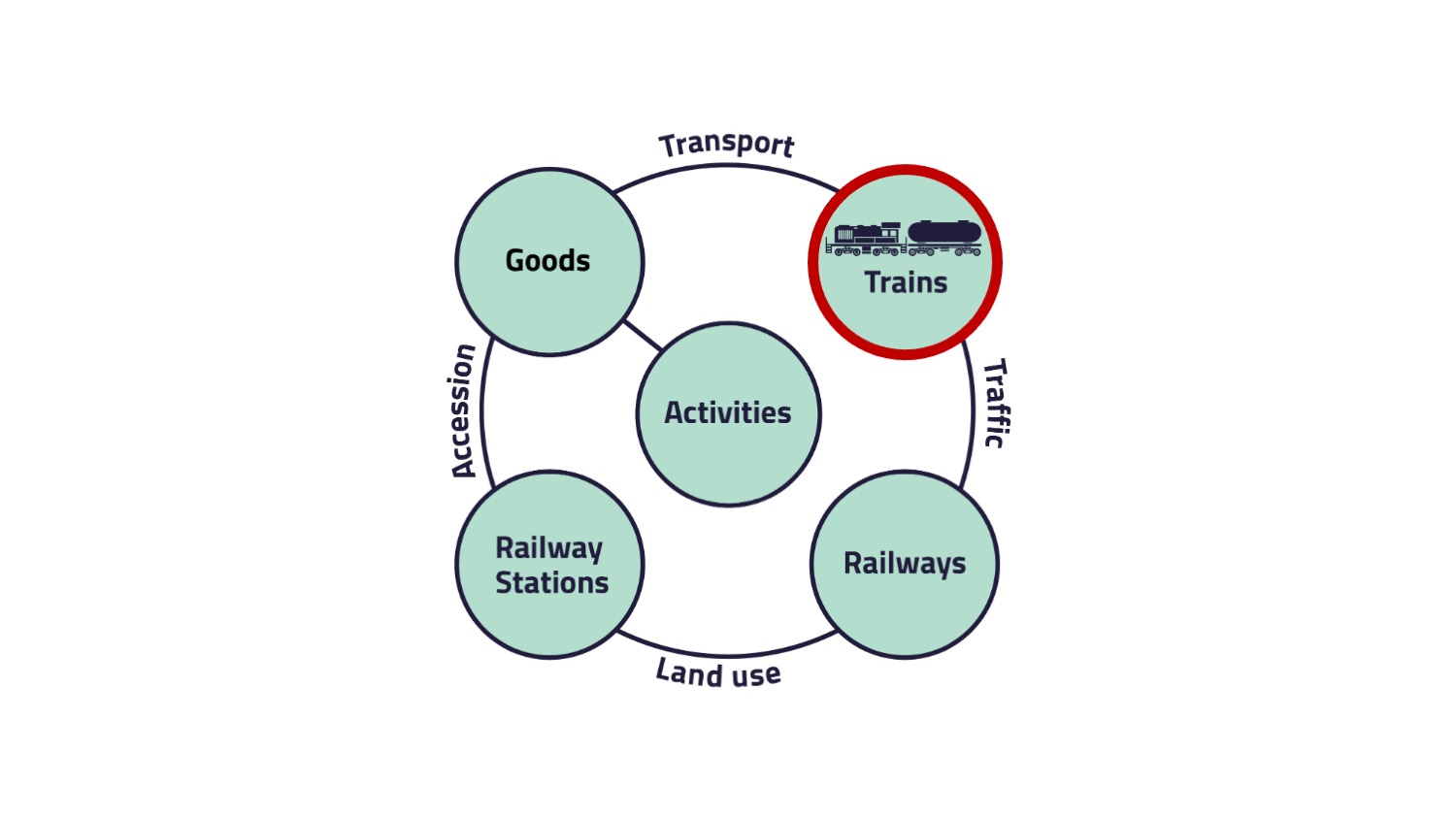
- Type E: Open Top Freight Wagon
- 2-axle and 4-axle
- open, solid, high-resistance box wagon
- The wagon can be loaded from the top using mechanized loading devices.
- This freight wagon is designed for the transport of weather-resisting bulk materials: Coal, ore, crushed rocks, etc.
- Type F: Open Hopper Wagon (Bulk freight wagon)
- The wagon takes advantage of gravity to unload its contents through two pairs of bottom doors.
- The self-unloading wagon is designed to transport sand, stone and other aggregate materials.
- Type H: High Capacity Sliding Wall Wagon
- A wagon with sliding walls, which permits easy side loading and unloading with forklifts.
- The wagon is best suited to transport paper coils, cellulose, sawn timber, sheets of plywood and goods on palettes.
- Type K: 2-axle Flat Wagon
- The wagon can be loaded and unloaded from the top and via side ramps.
- Materials can be protected against the weather by a waterproof tarpaulin.
- Type R: 4-axle bogie flat wagon
- This freight wagon is designed for the transport of heavy loads of packaged materials or long loads, such as steel pipes, profiles or lumber.
- Type S: 6-axle bogie flat wagon
- This freight wagon is particularly for heavy loads.
- Type T: Covered Hopper Wagon (Bulk freight wagon)
- The wagon with swivel or roll roof and sidewall doors for heavy cargo.
- Type T: Wagon with opening roof
- This freight wagon is particularly suitable for weather-sensitive goods.
- Type U: Tank wagon for forced air pressure discharge
- This freight wagon is specifically for the transport of powdery, granular goods.
- Type Z: Tank wagon
- This freight wagon is for the transport of liquids and gases.
- Type L: Car Carrier Wagon
- This freight wagon is designed to transport automobiles and vans.
- Combined Transport
- Large containers and swap bodies
Some of the presented train wagons are shown in the figure "Train wagons".
Traffic
In Germany for example, the regulations of the German train composition standards (Güterzugbildungsvorschrift (GZV)) for freight train formation are defining the following:
- For safety reasons, railway lines are divided into sections known as blocks.
- Normally, only one train is permitted in each block at a time.
- The train length influences the block allocation.
- The permissible maximum (total) train length is 740 metres; this corresponds to about 35 wagons (railcar length of 700 metres without driven head unit) and/or
- a regular train has a maximum of 250 axes. Under certain conditions it is up to 252 axes or/and
- the maximum permissible axle load is 22.5 t and/or the towing weight is 2,500 t.
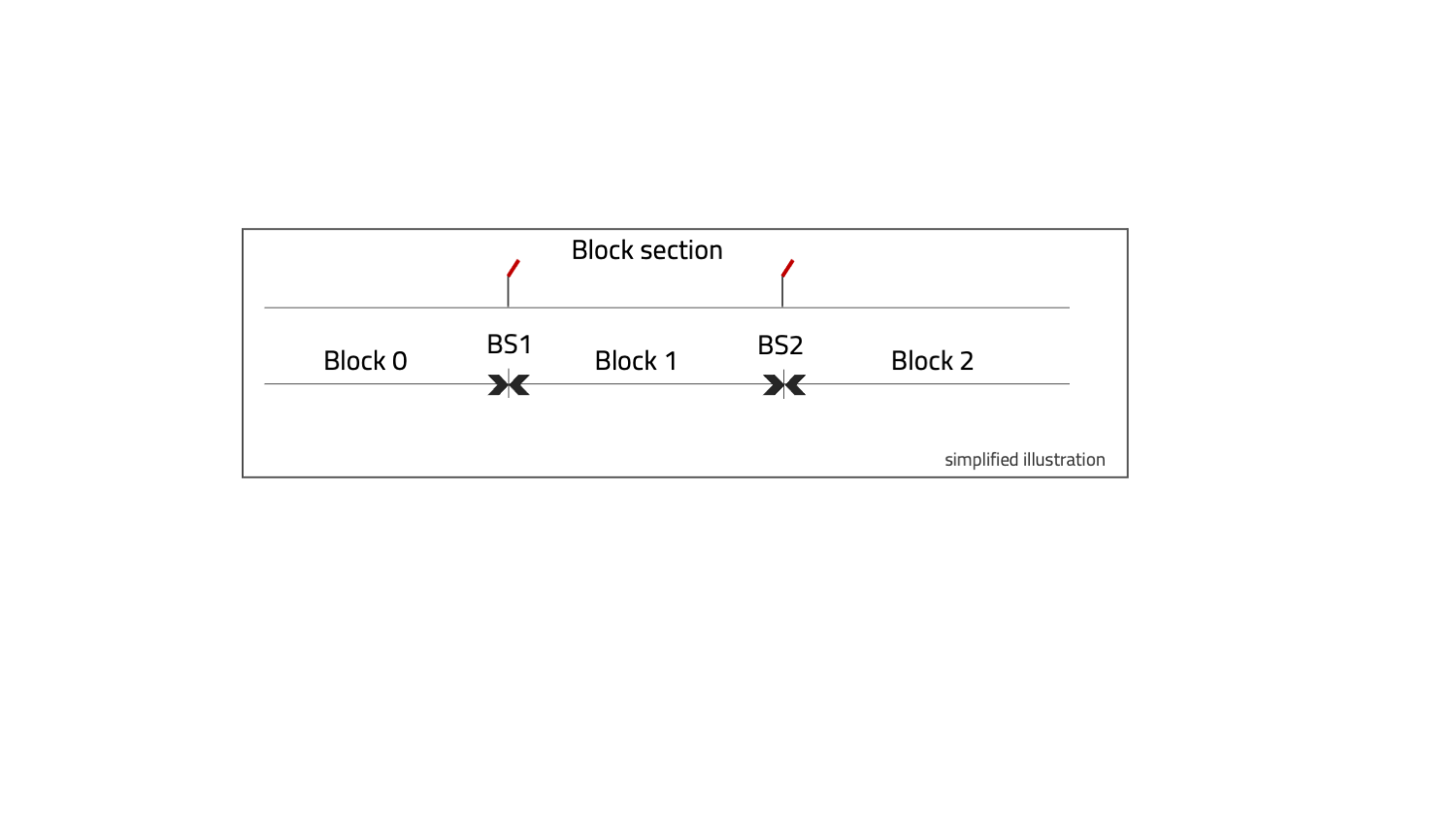
Exceptions for freight train compositions are:
- Bulk freight trains with special operational treatment up to 5,000 t.
- November 2008: For the first time, a 1,000 m freight train ran between Oberhausen and Rotterdam (Betuwe Route in the Netherlands only for freight trains).
- 2012: Freight trains between Padborg (DK) and Maschen (GER) with a length of 835 m (40 wagons), expanded 2016 to the Port of Hamburg (Hohe Schaar).
- In order to operate a train that exceeds the normal dimensions, some adjustments of infrastructure and operations are required:
- extension of passing tracks
- adjustment of control and safety technology
- extension of block sections
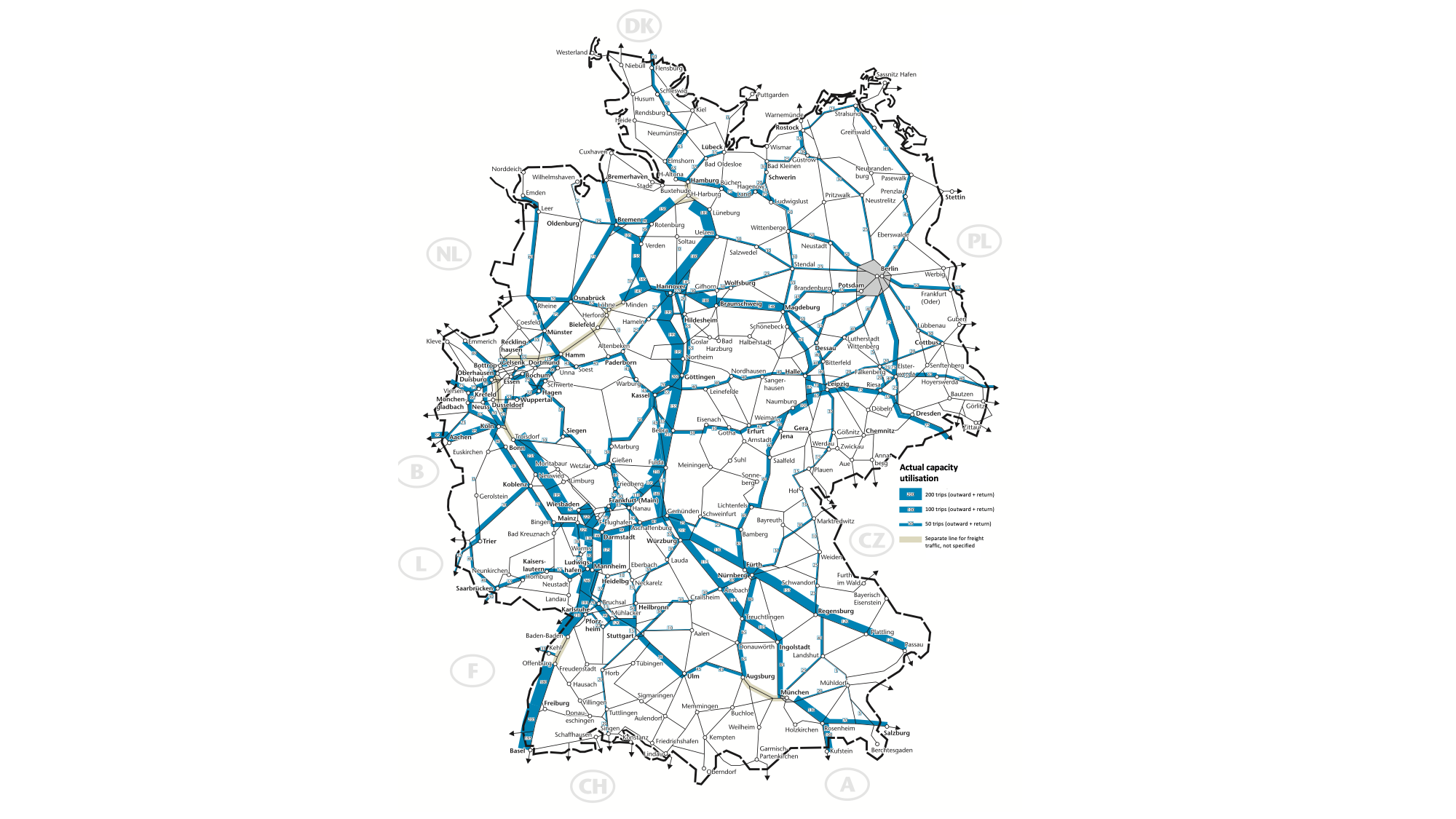
- Rhine Graben: ARA-ports (Amsterdam-Rotterdam-Antwerp)-Duisburg-Koblenz-Mainz-Mannheim-Karlsruhe-Basel
- North-south route: Hamburg-Hanover-Fulda-Würzburg-Munich-Brenner (incl. Würzburg-Nuremberg-Passau-Vienna)
As mentioned above, different types of trains are used for rail traffic. In the following, we will discuss block trains, combined transport and single wagonload traffic.
Let’s start with the block train:
Block trains are complete trains, containing goods of one client, transported from point A to point B. The train does not need to be stopped for shunting procedures. Block trains require a large transport volume and are realized both in own-account transport and between major hubs in combined transport.
The advantages of block trains are the following:
- Block trains are the fastest product in the rail system because of the comparatively short transport times without stopping at the marshalling yard.
- The organization of block trains is less complex.
- The coordination of departure and arrival times of block trains is more flexible.
In the following we will give some examples of such block trains.
- DB Cargo AG:
- DBplantrain is planning the transport requirements a long time in advance, leading to a cost-effective planning. It regularly transports large volumes on fixed routes for fixed transport dates and times.
- DBflextrain arranges transport volumes, connections and operating times at short notice, offering a last-minute block train. Customers have maximum flexibility upon order placement.
- NYK Line Amsterdam-Duisburg:
- 80 TEU capacity per train, 6 trains per week (NYK Line)
- Transit time: Amsterdam - Duisburg in 7 hours
- Trans-Sibirian container train for BMW:
- Regular from 2011-2022, this new transport product enabled shorter transport durations for 10,000 -12,000 km of 14-16 days. Compared to maritime transport, only half the time is needed.
- 75% cost advantages in comparison to air transport, but 50% above costs for maritime transport.
- 400 trains with 35,000 containers in 2015
- Use of customer specific trains as "dedicated company trains“
- E.g. Trans-Siberian container train for BMW from Leipzig to Shenyang
In contrast to block trains, rail traffic can also be operated with single wagonload traffic.
In single wagonload traffic, individual wagons are loaded with goods at various locations and are then transferred to and sorted at marshalling yards. They are transported to the destination marshalling yard, where the individual wagons are separated. The customers use single wagons exclusively. Single wagonload traffic is a good option, if the customer wants to dispatch one or several wagons at the time but does not have enough quantity for a block train. It is more expensive and time-consuming than block trains because of the train composition and integration in the timetable and the multiple handlings of trains from origin to destination.
The advantages of single wagonload traffic are:
- available at short notice
- full network coverage in Europe
- flexible management of freight wagon loading and unloading processes
Furthermore, rail transport can be organised as combined transport.
Combined transport is a transport in integrated transport chains using two or more modes of transport. By using combined transport, the specific advantages of each mode of transport can be combined.
- accompanied combined transport („Rollende Landstraße“ / „rolling highway“)
- unaccompanied combined transport
For the use of the presented trains, a network of railways is necessary. This infrastructure will be presented to you on the next page.
Literature
DB Netz AG (2016): Seit 2016 verkehren 835 m lange Güterzüge auch aus dem Hamburger Hafen. URL:
https://fahrweg.dbnetze.com/fahrweg-de/kunden/betrieb/laengere_gueterzuege-1393340 (last access: 30.03.2022).
DB Netz AG (2022): Nutzungsbedingungen Netz der DB Netz AG (NBN 2022). URL: https://fahrweg.dbnetze.com/fahrweg-de/kunden/nutzungsbedingungen/nutzungsbedingungen/NBN/Nutzungsbedingungen-Netz-der-DB-Netz-AG-NBN-2022-5674326?contentId=5674324 (last access: 30.03.2022).
Doll, N. (2016): Bahnverbindung Deutschland-China ist eine Erfolgsgeschichte. URL: https://www.welt.de/wirtschaft/article160672317/Bahnverbindung-Deutschland-China-ist-eine-Erfolgsgeschichte.html (last acces: 30.03.2022).
Pachl, J. (2013): Systemtechnik des Schienenverkehrs. 7. Auflage. Springer Vieweg Verlag Wiesbaden.
Verkehrsrundschau (2008): Deutsche Bahn erprobt erstmals 1000-Meter-Güterzug.
URL: https://www.verkehrsrundschau.de/nachrichten/transport-logistik/deutsche-bahn-erprobt-erstmals-1000-meter-gueterzug-3020883 (last access: 30.03.2022).
5. Railways
The next element of the conceptual system model is infrastructure. In the rail transport system, the infrastructure is called "Railways". Those railways are needed for the realization of rail traffic.
On this page we deal with topics such as the infrastructural structure, interoperability and technical characteristics of the railway track.
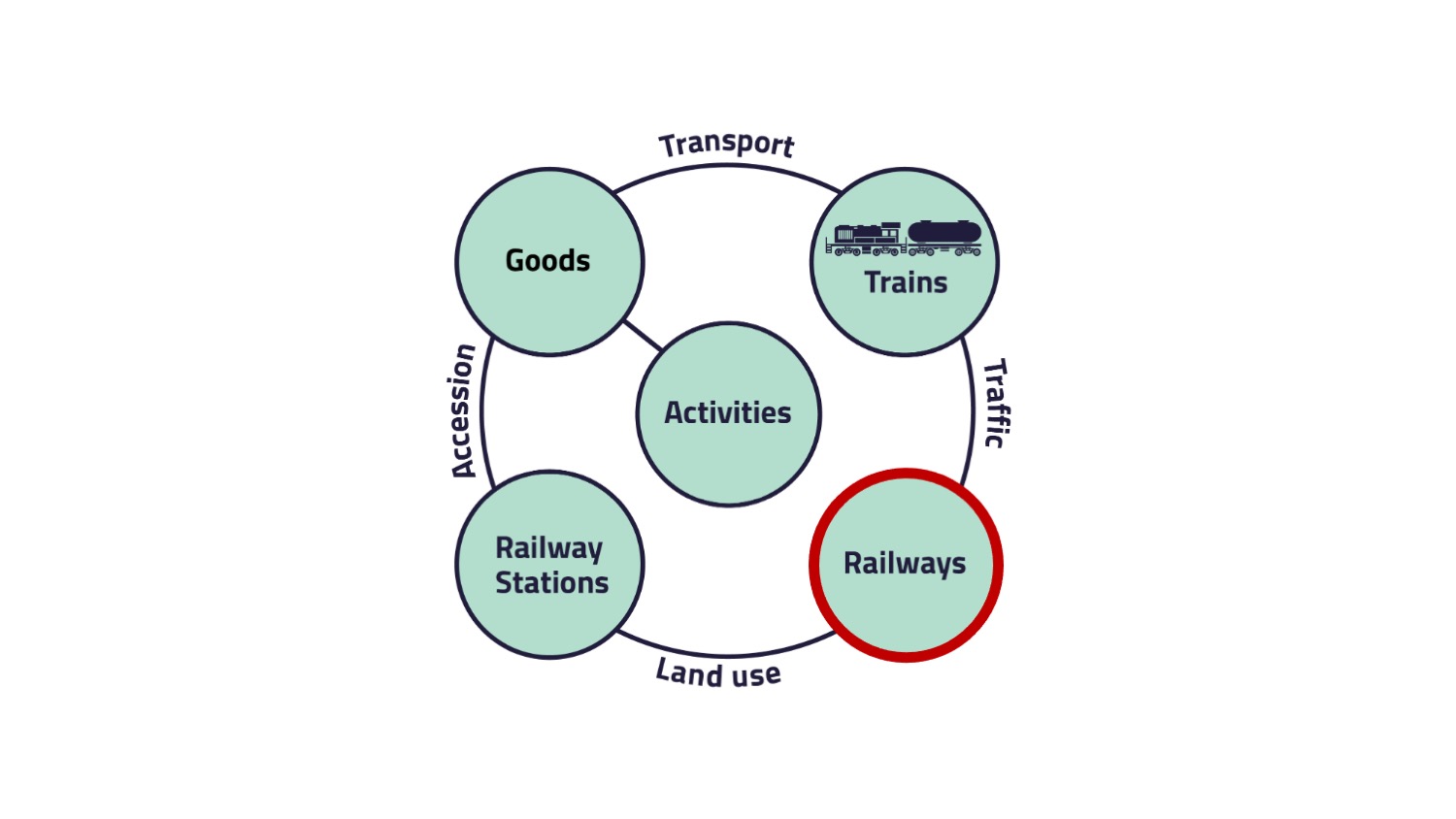
Rail Infrastructure
The global railway system is dominated by six main track gauges.
- The 1435 millimeters gauge accounts for about 60% of the total gauge kilometers and was introduced in North America and most of Western Europe, for example.
- The 1520 millimeters gauge accounts for about 17% of the total gauge mileage and has been introduced in Russia and some parts of Eastern Europe (Baltic States, Belarus, Ukraine).
- The Iberian broad gauge of 1668 millimeters is unique in Western Europe and was created by averaging the Spanish (1672 millimeters) and Portuguese (1665 millimeters) broad gauge.
Rail networks in Europe
Rail connections are not limited by national borders, so the different railway systems need to ensure a safe and seamless movement of trains.
This so called interoperability is the ability (of the trans-European rail system) to facilitate safe and seamless movement of trains. The interoperability is hampered by differences, not only in the European rail infrastructure, for example:
- power systems (voltage and safety systems, pantographs width),
- track gauges,
- clearance profiles and loading gauges profiles.
In Europe, interoperability is regulated in the Trans-European railway interoperability regulation and technical specifications (TSIs)
As you read before, the power systems are hampering the interoperability. In order to ensure a barrier-free transition between the rail networks, there are different ways to cope with the different power systems, which will be presented to you in the following.
Power system
Multi-system trains can be operated in different voltage and pantograph systems and/or using additional diesel engines:
- Since 1960, two-and multi-system locomotives are used in transnational rail traffic, eliminating the time-consuming need to change locomotives.
- Multi-system trains are used in particular in the high-speed rail system (e.g. Thalys operated between Cologne and Paris (1997)).
- Currently, the ICE 3 MS/Neo (407 and 408 series) operates between Germany, France, Belgium and the Netherlands.
- Since June 2007, the TGV POS runs between Paris, Eastern France and Southern Germany.
The figure "Voltage and safety systems" shows the different voltage and safety systems that are existing in different countries. The different systems are either using direct current with 1.5 kV or 3 kV or alternate current with 15 kV – 16.7 Hz or 25 kV – 50 Hz.
In the figure "Pantograph width", you can see the different pantograph widths of the railway network in Europe, which is varying from 1450 mm, over 1800 mm and 1900 mm up to 2050 mm.
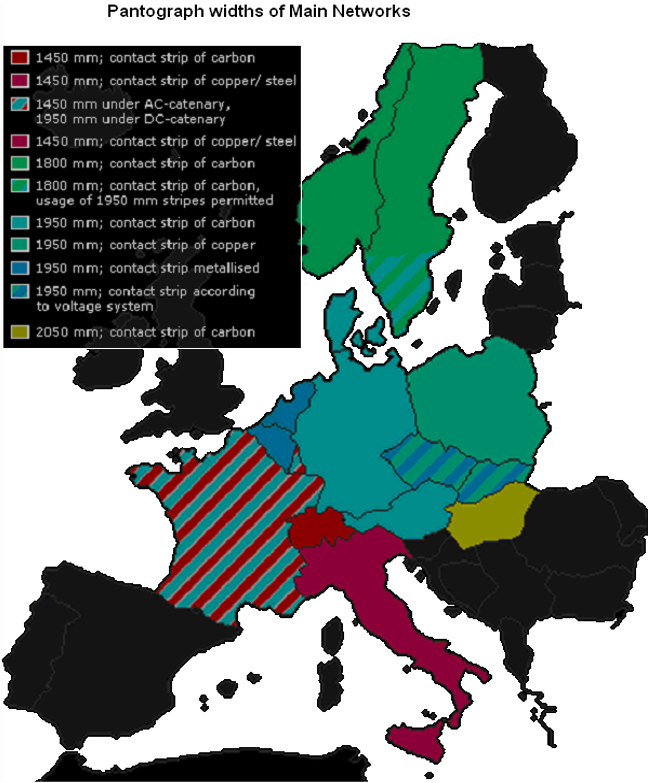
In addition, a barrier-free rail network requires common technical standards such as track gauge and direction of travel, which are presented below.
Driving direction
The figure "Driving directions" shows the different driving directions of the trains in Europe. In some countries, trains run on either the right or the left track, while in some countries, trains run on both the right and left track.
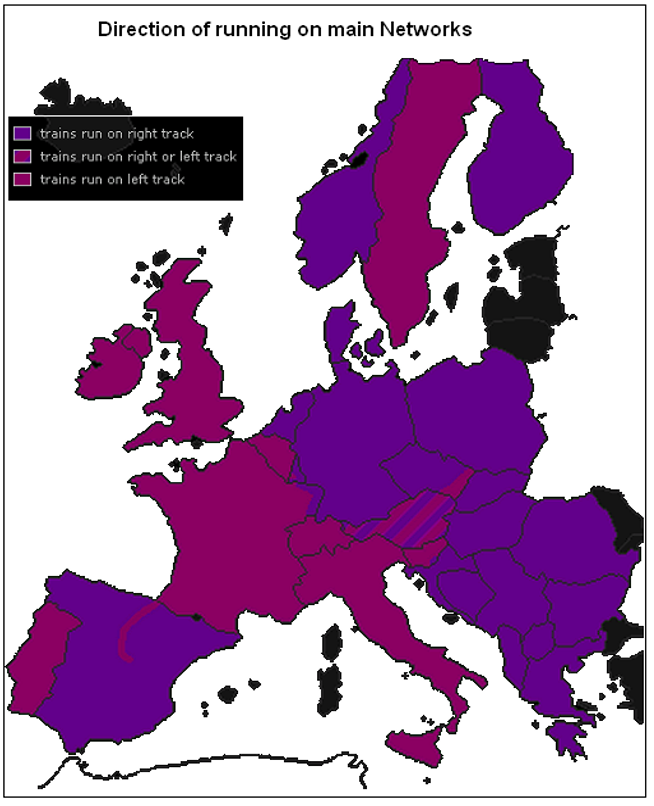
If the track gauges are not the same size, there are several opportunities to overcome this obstacle:
The simplest version is the transfer of passengers and transshipment of goods, for example with containers.
Another option is the exchange of axles / bogies. This change of wheel sets is common in freight traffic to the Iberian Peninsula, as well as to Finland, while in Russia the entire bogie is changed.
The figure "Track gauges" gives you an overview of the different track widths/gauges in Europe. In most of Europe, the standard gauge has a width of 1435 mm. Only in some eastern countries like Russia and Finland the gauge width is 1524 mm, while in Spain and Portugal the width is 1668 mm.
The next two sections deal with the clearance gauge. This describes a defined vehicle boundary line that guarantees the unrestricted passage of transport vehicles and their loads.
Structure gauge
The following figure shows two structure gauges. The structure gauge is the minimum clearance outline of the wagon. The structure gauge determines the minimum height and width of tunnels and bridges required for a safe use of the railways.
While the right structure gauge (G1 profile) can be used throughout Europe, the large volume wagons on the left (G2 profile) are too big for some countries and therefore can’t be used in UK, France, Italy, Belgium and Switzerland.
Loading gauge profile
Defines the maximum height and width for railway vehicles and loads and ensures the safe passage through bridges, tunnels and other structures. The figure shows the different loading gauges for the UK, France, Germany and the Eurotunnel. In the UK, the headroom above rail level is only 3.96 m, while the Eurotunnel has a headroom above rail level of 5.60 m.
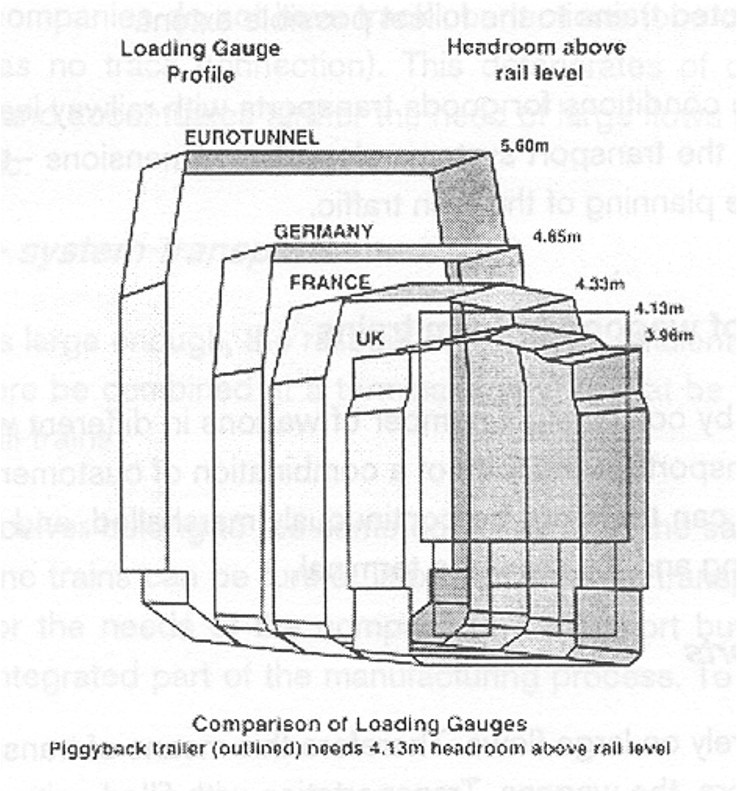
One example for a transcontinental line is the Trans-Asian railway. The interest for a long-distance rail connection between Asia and Europe was renewed in the 21st century. These connections have become known as the Trans Asian Railway, the Northern East-West Corridor, the Eurasian Land bridge, the New Silk Road or the BRI (Belt and Road Initiative). Among the numerous challenges the corridor is facing the rail system operates on two gauges, standard (1435 mm; China and most of Western Europe) and broad (1520 mm; Russia and some Scandinavian countries)
5.1. Quiz - Interoperability
6. Railway Stations
This page deals with the last element of the conceptual system model facilities. In the rail transport system, the facilities are called "Railway Stations".
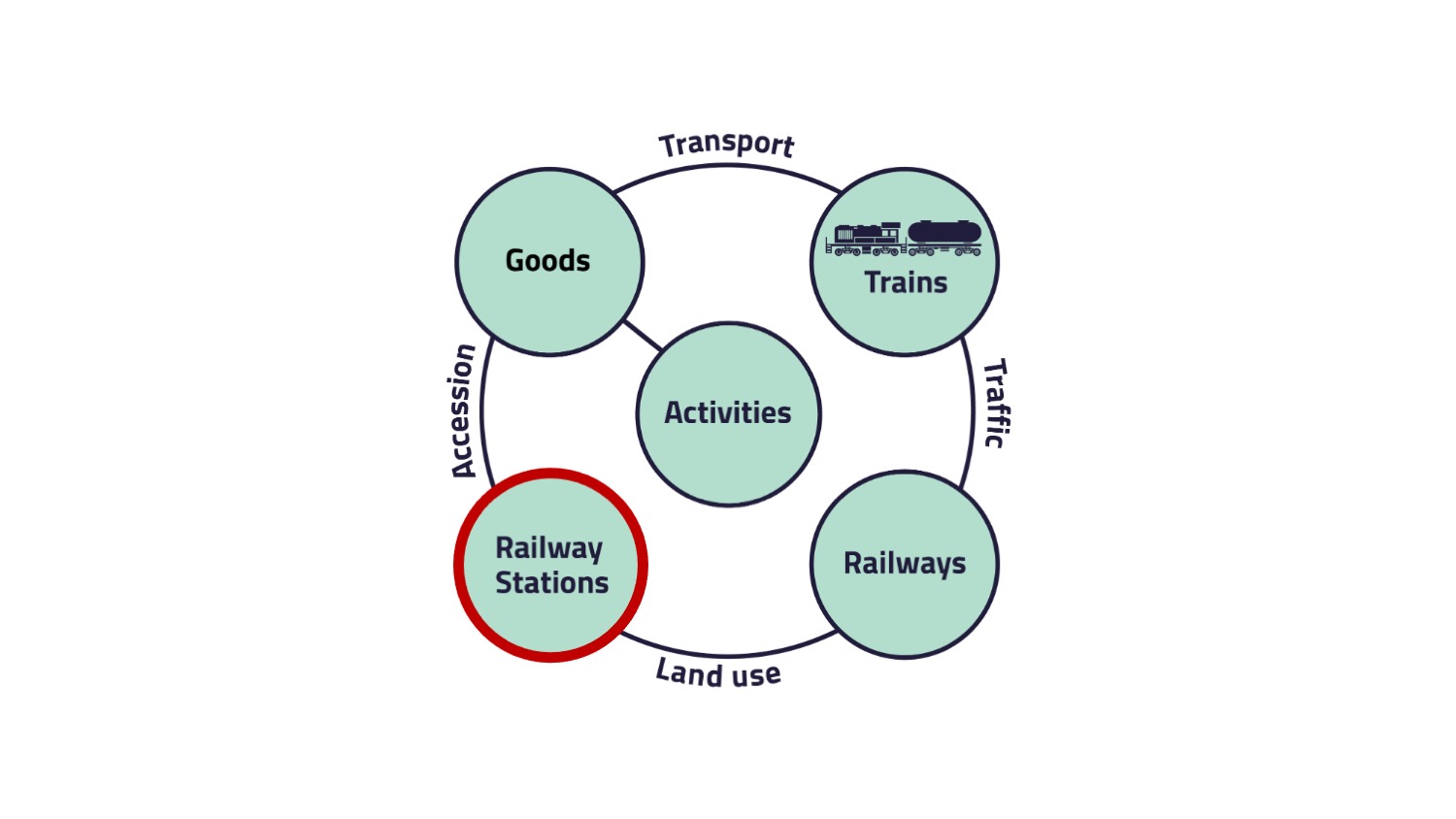
In the transport chain without block trains, marshalling yards are often used to form regional, national and international freight trains. Near Hamburg is the largest marshalling yard in Europe called Maschen. Some key facts about the Maschen marshalling yard:
- In operation since 1977, underwent major modernization between 2009 and 2014.
- Largest marshalling yard in Europe for regional, national and international freight train formation.
- Hub for hinterland transport of maritime ports of Hamburg and Bremerhaven as well as Scandinavia traffics.
- Currently, around 1 million freight wagons are treated (150 trains / up to 4.000 wagons daily).
- Maschen is a hump yard.
- Lead track on a hill (hump) that an engine pushes the cars over. Cars are uncoupled just before the hump, and roll by gravity into their destination tracks.
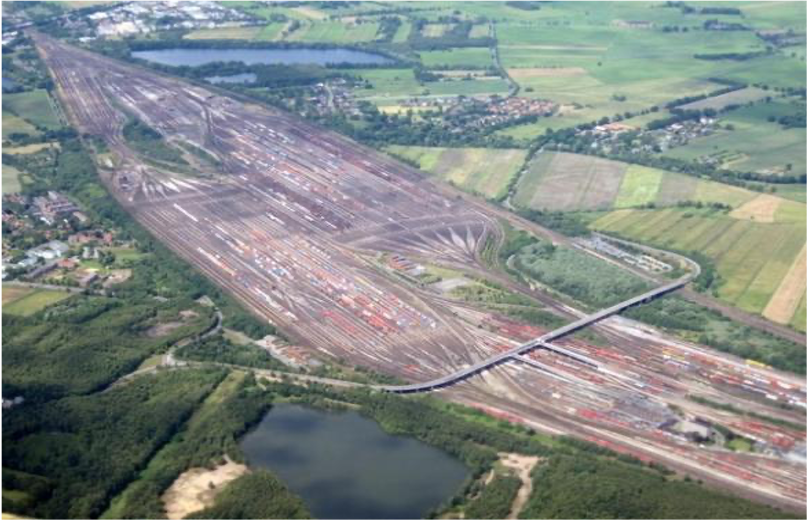
Accession
Literature
Deutscher Bundestag (2019): Gleisanschlüsse im deutschen Bahnnetz. Drucksache19/9305. Antwort der Bundesregierung auf die Kleine Anfrage der Abgeordneten Sabine Leidig, Dr. Gesine Lötzsch, Lorenz Gösta Beutin, weiterer Abgeordneter und der Fraktion DIE LINKE. – Drucksache 19/8731 –. URL: https://dserver.bundestag.de/btd/19/093/1909305.pdf (last access: 30.03.2022).
7. Summary
Overall Rail transport is safe and reliable. The high environmental friendliness and, in addition, the high transport capacity make rail transport attractive. What speaks against it, however, are the high capital intensity and the general inflexibility.
More advantages and disadvantages of rail transport are listed below.
- safe transport
- exact time tables, reliable
- hazardous goods permissible
- no general driving ban on Sundays
- heavy lift traffic handling
- economy of scale → advantage only for block-trains and direct trains
- high transport capacity
- higher single loading weight compared to trucks
- own infrastructure → certain level of independence (e.g. no traffic jam)
- relatively fast point to point delivery
- if electrified, best ecological performance compared to other transport modes
- low energy consumption per tkm, based on transported unit
- opportunities for automation
Disadvantages
- no complete coverage and in most countries reduction of the track network
- inflexible operations through binding timetable
- inflexible due to high expenditures of time and costs for the preparation and implementation of transportation
- capital-intensive set-up, operation and maintenance costs
- high external costs
- exclusion of certain dangerous goods
- no seamless interfaces between competing railway networks under separate ownership (interoperability and non-discrimination)
Literature
7.1. Quiz - Advantages and Disadvantages of rail
Now that you've looked at all the elements of the rail transport system, here are some quiz questions again for testing your knowledge:
8. Literature
Bundesministerium für Verkehr, Bau- und Wohnungswesen (2004): Verkehr in Zahlen 2004/2005. 33. Jahrgang, URL: https://www.bmvi.de/SharedDocs/DE/Publikationen/G/verkehr-in-zahlen_2004-pdf.pdf?__blob=publicationFile (last access: 30.03.2022).
Bundesministerium für Verkehr und digitale Infrastruktur (2020): Verkehr in Zahlen 2020/2021. 49. Jahrgang, URL: https://www.bmvi.de/SharedDocs/DE/Publikationen/G/verkehr-in-zahlen-2020-pdf.pdf?__blob=publicationFile (last access: 30.03.2022).
DB Cargo AG (2021): Ganzzugverkehr: Ihre Wahl für große Mengen. URL: https://www.dbcargo.com/rail-de-de/leistungen/schienentransporte/Ganzzug (last access: 30.03.2022).
DB Netz AG (2016): Seit 2016 verkehren 835 m lange Güterzüge auch aus dem Hamburger Hafen. URL:
https://fahrweg.dbnetze.com/fahrweg-de/kunden/betrieb/laengere_gueterzuege-1393340 (last access: 30.03.2022)
Deutscher Bundestag (2019): Gleisanschlüsse im deutschen Bahnnetz. Drucksache19/9305. Antwort der Bundesregierung auf die Kleine Anfrage der Abgeordneten Sabine Leidig, Dr. Gesine Lötzsch, Lorenz Gösta Beutin, weiterer Abgeordneter und der Fraktion DIE LINKE. – Drucksache 19/8731 –. URL: https://dserver.bundestag.de/btd/19/093/1909305.pdf (last access: 30.03.2022).
Flämig, H., Sjöstedt, L., Hertel, C. (2002): Multimodal Transport: An Integrated Element for Last-Mile-Solutions? Proceedings, part 1; International Congress on Freight Transport Automation and Multimodality: Organisational and Technological Innovations. Delft, 23 & 24 May 2002. (modification of Sjöstedt 1996)
Verkehrsrundschau (2008): Deutsche Bahn erprobt erstmals 1000-Meter-Güterzug.
URL: https://www.verkehrsrundschau.de/nachrichten/transport-logistik/deutsche-bahn-erprobt-erstmals-1000-meter-gueterzug-3020883 (last access: 30.03.2022)
